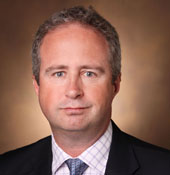Andrew Shaw, M.B. B.S., has been named chief of Vanderbilt’s Division of Cardiothoracic Anesthesiology.

Internationally recognized in the field of cardiothoracic anesthesiology, Shaw comes to Vanderbilt from Duke University Medical Center. He has practiced cardiothoracic anesthesiology and critical care medicine for more than 20 years in the United Kingdom and the United States, has co-authored three textbooks and more than 120 original papers.
Shaw’s research focus is in the area of postoperative morbidity and surgical critical illness, particularly acute kidney injury, and his investigations are funded largely by the National Institutes of Health and the U.S. Department of Defense.
He is well known for his ready pursuit of research that challenges accepted practices in clinical care. For example, in 2012 he published a landmark paper in Annals of Surgery in which he highlighted a hazard of resuscitation with 0.9 percent saline — the most commonly prescribed intravenous fluid in the United States and abroad. Subsequent papers from other groups have confirmed this hazard, and now the largest randomized controlled trial in surgical patients ever conducted worldwide will address this issue.
“Andy doesn’t hesitate to question existing dogma, and that’s exactly the kind of leader we want at Vanderbilt,” said Warren Sandberg, M.D., Ph.D., chair of the Department of Anesthesiology. “He conducts research into the question, and is able to make field-changing contributions that dramatically improve patient care and safety. Here, he will continue to pursue this sort of pioneering research by combining his interest and talents in personalized medicine, epidemiology and pharmacogenomics with the strong institutional commitment already here, bringing these concepts to the bedside of perioperative patients.”
Shaw is a fellow of the Royal College of Anaesthetists (United Kingdom), a fellow of the American College of Critical Care Medicine and a fellow of the Faculty of Intensive Care Medicine (UK).
Shaw received his medical degree from St. Bartholomew’s Hospital Medical College, University of London, in 1992. He completed internships in the Department of Internal Medicine at Northampton General Hospital, St. Bartholomew’s Hospital, and the Royal Free Hospital (London) followed by residency training in the Department of Anesthesiology at the Imperial School of Anaesthesia, North West Thames Deanery. After his residency, Shaw completed cardiothoracic anesthesiology and critical care fellowship training at Royal Brompton and Harefield hospitals in London. In 1999, Shaw joined the Department of Anesthesiology at the University of Texas M.D. Anderson Cancer Center as a visiting assistant professor, joining the faculty full time in 2002. In 2005, he Shaw was recruited to Duke University’s Division of Cardiothoracic Anesthesiology and Critical Care Medicine and there was promoted to associate professor.
“Vanderbilt is a perfect fit for my research and clinical interests,” Shaw said. “Many of the Cardiothoracic Anesthesiology Division’s faculty members are already conducting groundbreaking, extramurally funded research. Their work excites me, and the collaborative atmosphere of this institution is exactly where I want to be at this point in my career.”
The Division of Cardiothoracic Anesthesiology works alongside Vanderbilt Heart and Vascular Institute surgeons and cardiologists to perform approximately 1,200 adult cardiac procedures annually, including ventricular assist device (VAD) insertions and percutaneous aortic valve replacements. In addition to cardiac surgery, the division works with thoracic surgeons to complete approximately 600 general thoracic cases annually. Anesthesia services are also provided for interventional pulmonary procedures, electrophysiology procedures and other non-OR cardiothoracic and major vascular procedures, which together total approximately 2,500 cases yearly.















